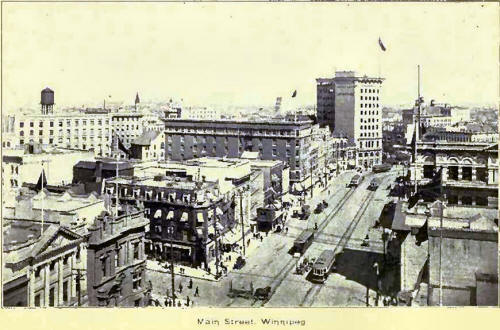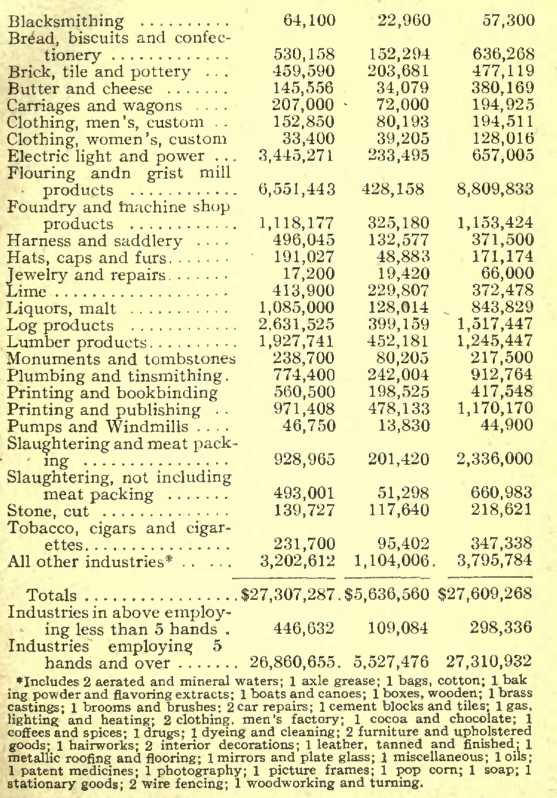|

MANITOBA
as an industrial centre is not of course at all comparable with the
great manufacturing districts of the Old World. In considering the
Province as a centre of industrial activity, it is to be remembered that
Western Canada is the newest of all new countries. It is chiefly
agricultural and its native resources are yet scarcely realized.
Its
progress, however, in industrial matters has been remarkable. It has
developed from a village in which the manufacturing industries were
confined to the mak-mg of moccasins by Indian squaws, and the turning
out of horseshoes, wagon bolts and harrow teeth by the village
blacksmith, into the fourth cityjn all Canada, as estimated by the value
of its manufactured products. This, in 1908, was estimated at about
$25,000,000.
Winnipeg is the greatest wheat market in the British Empire. Nearly all
of the great grain crop of Western Canada, which in 1908 amounted no
less than 222,786,058 bushels of wheat, oats, barley, flax and rye,
passes through the city. For many years all the manufactured articles
used in Western Canada were imported, but the advantages to be derived
from home industries are now beginning to be realized. Numerous home
industries depend to a large extent upon mixed farming, which it is now
admitted must be adopted to a greater, extent 1han has hitherto been the
case.
Some idea of the progress made by Manitoba in industrial development,
may be gathered from recent census returns:—The census in Manitoba, in
1881, showed 314 industrial establishments, great and small, with a
total output of $3,413,026. Ten years later there were 1,031
establishments with a total output of $10,155,182, that is to say, that
there had been an increase of 200 per cent, in ten years. In 1901, the
census was taken on a different basis, only establishments employing
five or more hands being counted. The 1906 census showed that the ratio
of increase was be-corung greater with each year. The capital invested
has more than trebled in five years, and the amount of salaries paid,
and also the output, have more than doubled.
In
the five years from 1901 to 1906, Winnipeg made the enormous increase in
manufactured products, of one hundred and twenty-five per cent; the
value of such goods advanced from $8,616,218 to $18,983,290. For the
year of 1907, it was estimated that the value of goods manufactured in
the City of Winnipeg, amounted to $22,000,000. There are to-day, one
hundred and forty-eight factories and work shops, and no less than
12,000 hands directly employed in these. This number does not include
the army of men employed in the municipal departments and the great
railway yards of the city, but applies only to those engaged in actual
making of goods from raw material.
The
results of the last Dominion Census published in 1906, relating to the
number of manufacturing firms in Manitoba, the capital invested, the
nature and value of goods produced and the amount of money paid out In
salaries and wages, are shown in the following table: —


Among the more important work shops and factories in Winnipeg, are those
of the Canadian Pacific, the Canadian Northern and the Grand Trunk
railroads. The Vulcan Iron Works, the Manitoba Iron Works, the Western
Iron Works, the Northern Iron Works, and ten smaller machine shops, in
all employing more than 3.650 hands. In addition, there is in Winnipeg
an iron rolling-mill, turning out bar and rolled iron, and five plants
are engaged in the manufacture of wire fencing of various sorts—a
product greatly in demand through out Western Canada, where fencing
material of wood or stone is scarce and the stretches of land that
require to be fenced are very great. There are also four factories for
making sheet metal cornices and galvanized iron work; seven brick, clay
and cement works; two paint factories; two shops that turn out stained
glass products; nine planing mills, which manufacture building materials
such as sashes and doors, office and bank fittings; one plant which
manufactures plaster for hard-hmshing walls, the raw material being
native gypsum.
Five factories which manufacture ready-made clothing, employ 350 hands.
Fur garments are also largely made in Winnipeg. Although many furs are
dressed in the city, the majority are exported; the annual output of
undressed pelts of fur-bearing animals is valued at $350,000. Most of
these are gathered by the employees of the Hudson’s Bay Company.
Other important industries carried on in Winnipeg, are the preparation
of pickles and vinegar, condiments, baking powder, bag and box
manufacture, engraving, electro-plating, brass-foundering, soap making,
coopering, furniture making. In the province there are also glass works
and the fish industry of Manitoba is of great importance (see special
article on Fisheries, by Pro fessor Prince). In the neighborhood of the
larger towns poultry rearing and market gardening form important
industries.
We
must not neglect to mention other important manufacturing towns and
cities of the province. In 1901, the value of Brandon’s output of
manufactures was $541,327, and in 1906, this had advanced to $2,007,995,
while Portage la Prairie made the notable increase, in the same period,
from $803,290 in 1901 to $1,858,000 in 1906. Brandon, the second city in
size in Manitoba, has numerous wholesale warehouses, and in addition
there are thirty factories. Among the products of these may be mentioned
gasoline engines, well-boring machinery, fire and bar fixtures, sashes
and doors, pumps and windmills, harness, tents and awnings, cement
blocks, mattresses, beer and ale, boilers, bricks, wagons, cut stone and
monuments, etc. The Canadian Pacific Railway Company maintains
divisional repair shops, employ a large number of men, ang the total
number employed by the factories exceeds 1,000. The city of Brandon also
possesses a crushing plant and sewer-pipe works.
At
Portage la Prairie, the chief industries within the town are a flour
mill, an oatmeal mill, a wire fence factory, a brick yard, a foundry and
a planing mill.. This city is the centre of a very important wheat
growing district. At Carberry, there is a flour mill with a capacity of
200 barrels daily, and also seven elevators that have a capacity of
180,000 bushels of grain.
At
Carman, are located two flour milling plants, and at Dauphin, several
elevators and lumber mills. In Gladstone, there is a flour mill with a
capacity of 300 barrels daily ; at Grandview, a large saw-mill and sash
and door factory.
In
the neighborhood of Stonewall, the gardening and poultry industry is
carried on to some extent by the German farmers, and within the town are
several stone quarries with a combined annual output valued at nearly
$200,000.
At
Rapid City, there are several industries, including a woollen mill,
grist mill, brick yard and lime kiln works, besides a flour mill of 175
barrel capacity.
In
the near future, thousands of miles of new railways will be constructed
in the three prairie provinces alone, new towns and cities are being
established almost daily, and large tracts of country are rapidly being
brought under cultivation,. Within the next few years, therefore, there
is bound to be an enormous demand for all kinds of railway equipment,
for every variety of mumci pal plant, for agricultural implements, and
all the vast assortment of manufactured goods required in the building
up if civilized communities.
At
present, there are no boot and shoe factories in Western Canada,. The
total value of these commodities sold annually in the West amounts to
$3,500,000, and in Winnipeg alone, the annual sales of leather gloves
and mittens amount, it is stated, to about $1,000,000. In a country
which is largely engaged in stock-raising and in the export of raw hides
and skins, it is somewhat remarkable that there are no tanneries, and
that leather goods are not manufactured.
Motor cars are used very largely, not only in the cities of Western
Canada, but in the country. The first automobile introduced into
Winnipeg, was a threewheeled Knox car, in 1901, and now there are over
300 in the city. These are chiefly of United States manufacture. As a
duty of 35 per cent, is charged on imported cars, it seems obvious that
these might be profitably manufactured in Western Canada.
Other industries must, sooner ot later, be introduced. For example, the
utilization of flax fibre, the manufacture of potato starch, the growing
of sugar-beets and the manufacture of alcohol, are all obvious
possibilities.
When the great extent of Western Canada and its rapid development are
considered, it must be apparent that it offers an unprecedented market
for the products of almost every conceivable kind of manufacture.
The
great distance from large manufacturing centres involving as it does
proportionately great freight charges, and the high duty on imported
manufactured goods, will compel, ere long, the foundation of a large
number of factories to supply even the home demand, to say nothing of
the possibilities of an export trade in certain branches. Natural
resources are not wanting to supply the necessary raw materials, and the
energy and capacity of the citizens of the West ensure the successful
establishment and development of numerous home industries. |
